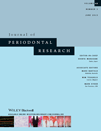Expression profiling of microRNAs in RAW264.7 cells treated with a combination of tumor necrosis factor alpha and RANKL during osteoclast differentiation
Abstract
Background and Objective
Tumor necrosis factor alpha (TNF-α), a cytokine involved in the pathogenesis of periodontal disease, induces osteoclast differentiation and indirectly promotes alveolar bone resorption. We investigated TNF-α-regulated osteoclast differentiation, focusing on microRNAs. MicroRNAs are small, noncoding RNAs that are involved in various biological processes, including cellular differentiation, proliferation and apoptosis. Aside from miR-21, miR-155 and miR-223, the identities of the microRNAs that play roles in osteoclast differentiation are unknown. Notably, no previous studies have reported the expression profiling of microRNAs during TNF-α-regulated osteoclast differentiation.
Material and Methods
We used microarrays to screen the levels of expression of mature microRNAs in RAW264.7 cells treated with a combination of TNF-α and RANKL, or RANKL alone for 0, 24 or 82 h during osteoclast formation. We validated the results of the microarray analyses through quantitative RT-PCR analyses of representative microRNAs in RAW264.7 cells and murine bone marrow macrophages.
Results
During osteoclast formation, the expression of 44 mature microRNAs differed by more than twofold between untreated cells and cells treated with a combination of TNF-α and RANKL, and the expression of 52 mature microRNAs differed upon RANKL treatment. According to quantitative RT-PCR analyses, miR-378 was upregulated and miR-223 was downregulated during osteoclast formation. Furthermore, miR-21, miR-29b, miR-146a, miR-155 and miR-210 were highly expressed during osteoclast differentiation in TNF-α/RANKL-treated cells compared with RANKL-treated cells.
Conclusions
These results suggest that miR-223 and miR-378 may play important roles in osteoclastogenesis, and that miR-21, miR-29b, miR-146a, miR-155 and miR-210 are involved in TNF-α-regulated osteoclast differentiation.




